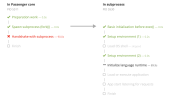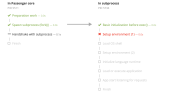heppyAndriawan
New Pleskian
- Server operating system version
- Ubuntu 20.04.5 LTS
- Plesk version and microupdate number
- Plesk Obsidian v18.0.46
Hi everyone,
I am really new to Plesk, and I am trying to follow the steps from this link below but it seems still not working.
 www.plesk.com
www.plesk.com
1. So first, I exported my Next app by typing npm run build, and after completing I convert everything including the .next folder but except the node module folder to a zip file.
2. after login into Plesk, I upload this file to File Manager in the directory "httpdocs/public/" as I read in the other articles that on Linux the node app only works properly from this directory, so then I create it.
3. After that I install the node extension and setup up the new app below:

if I click "Technical details" then it says I need to run the node app with the environment set to development and/or with the friendly error pages option set to "on" to see all the error details.
5. I change the application mode to development and then this shows up. I feel hopeless, and don't know what to do anymore.

Can anyone help me, what should I do? I am completely new to this case, I am really open to suggestions to solve this problem.
Thanks in advance.
I am really new to Plesk, and I am trying to follow the steps from this link below but it seems still not working.
Plesk Node.Js Setup
Plesk Node.Js setup guide. If you’re interested in hosting Node.js apps, we've got good news for you - Plesk Obsidian comes with a new Node.js extension.
 www.plesk.com
www.plesk.com
1. So first, I exported my Next app by typing npm run build, and after completing I convert everything including the .next folder but except the node module folder to a zip file.
2. after login into Plesk, I upload this file to File Manager in the directory "httpdocs/public/" as I read in the other articles that on Linux the node app only works properly from this directory, so then I create it.
3. After that I install the node extension and setup up the new app below:
*Node.js version: 18.12.0
*package manager: npm
*Document Root: "httpdocs/public/"
*application mode: production
*Application URL: Website Domain Names, Online Stores & Hosting - Domain.com
*Application Root: "httpdocs/public/"
*application launch file: server.js => ("This is an Express API / listening API router")
*Custom Environment Variables: "some env variable to connect to a database like a host, database name, User name, password"
4. Next step I press "Enable Node.js" to activate the app and install all dependencies by pressing “NPM install” then after all is installed then I click Application URL to check the website but I got this:
if I click "Technical details" then it says I need to run the node app with the environment set to development and/or with the friendly error pages option set to "on" to see all the error details.
5. I change the application mode to development and then this shows up. I feel hopeless, and don't know what to do anymore.

Can anyone help me, what should I do? I am completely new to this case, I am really open to suggestions to solve this problem.
Thanks in advance.


